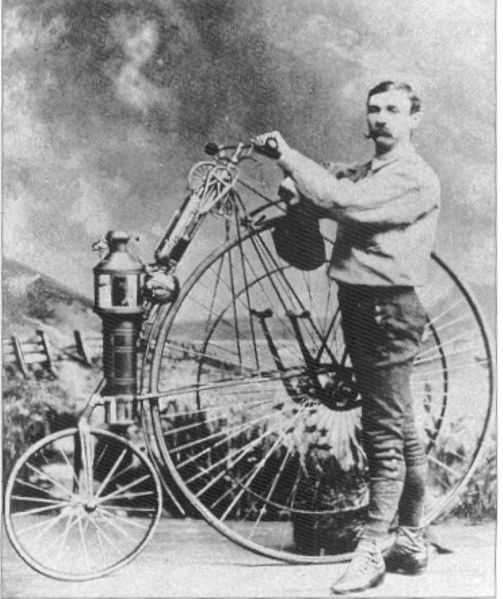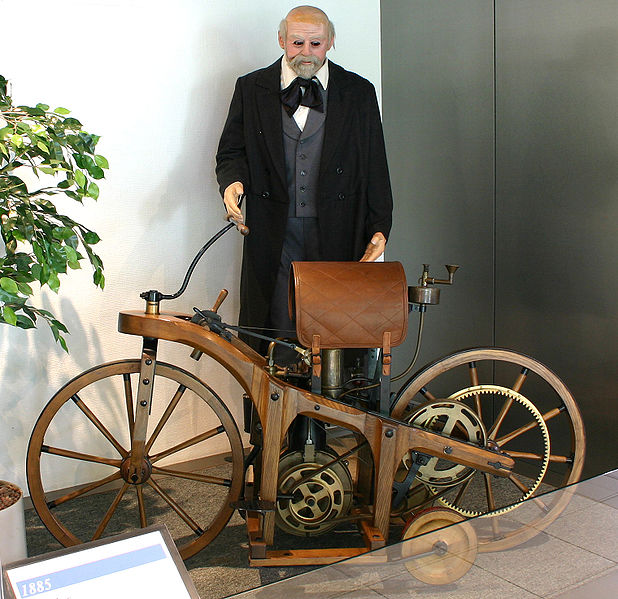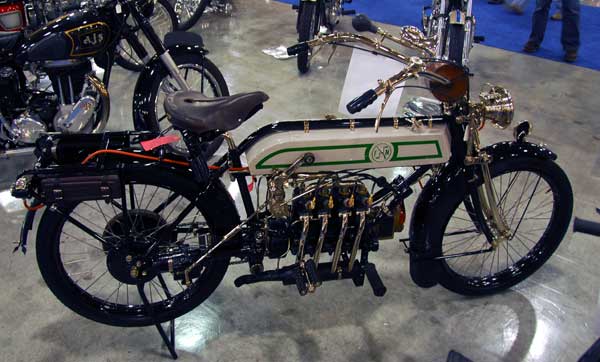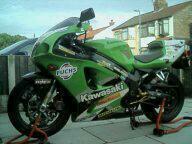
Saturday, 21 July 2012
Worlds First Motorcycle-- History of Motorcycle

The First Motorcycle was designed and built by the German inventors Gottlieb Daimler and Wilhelm Maybach in Bad Cannstatt (Stuttgart) in 1885.
Motorcycle history begins in the second half of the 19th century. Motorcycles are descended from the "safety bicycle," a bicycle with front and rear wheels of the same size and a pedal crank mechanism to drive the rear wheel. Despite some early landmarks in its development, motorcycles lack a rigid pedigree that can be traced back to a single idea or machine. Instead, the idea seems to have occurred to numerous engineers and inventors around Europe at around the same time.

Early pioneers
Steam power
In the 1860s Pierre Michaux, a blacksmith in Paris, founded 'Michaux et Cie' ("Michaux and company"), the first company to construct bicycles with pedals called a velocipede at the time, or "Michauline". The first steam powered motorcycle, the Michaux-Perreaux steam velocipede, can be traced to 1867, when Pierre's son Ernest Michaux fitted a small steam engine to one of the 'velocipedes'.
The design went to the USA when Pierre Lallement, a Michaux employee who also claimed to have developed the prototype in 1863, filed for the first bicycle patent with the U.S. patent office in 1866. In 1868 an American, Sylvester H. Roper of Roxbury, Massachusetts developed a twin-cylinder steam velocipede, with a coal-fired boiler between the wheels. Roper's contribution to motorcycle development ended suddenly when he died demonstrating one of his machines in Cambridge, Massachusetts on June 1, 1896.
Also in 1868, a French engineer Louis-Guillaume Perreaux patented a similar steam powered single cylinder machine, the Michaux-Perreaux steam velocipede, with an alcohol burner and twin belt drives, which was possibly invented independently of Roper's. Although the patent is dated 1868, nothing indicates the invention had been operable before 1871.
In 1881, Lucius Copeland of Phoenix, Arizona designed a much smaller steam boiler which could drive the large rear wheel of an American Star high-wheeler at 12 mph. In 1887 Copeland formed the Northrop Manufacturing Co. to produce the first successful 'Moto-Cycle' (actually a three-wheeler).

Copeland stoomfiets 1894
Petroleum power
The Reitwagen was designed and built by the German inventors Gottlieb Daimler and Wilhelm Maybach in Bad Cannstatt, near Stuttgart, in 1885. It was the first petroleum-powered vehicle, running on a light gasolene. Previous engines designed by Nikolaus Otto has been powered by town gas. The German name Reitwagen means "riding car". Daimler created this machine solely as a testbed to prove that his Grandfather Clock engine could work in a vehicle.

Replica of the 1885 Daimler-Maybach---Daimler-1-motorcycle-1
First commercial products
In the decade from the late 1880s, dozens of designs and machines emerged, particularly in France, Germany and England, and soon spread to America. During this early period of motorcycle history, there were many manufacturers since bicycle makers were adapting their designs for the new internal combustion engine.
In 1894, the Hildebrand & Wolfmüller became the first motorcycle available to the public for purchase. However, only a few hundred examples of this motorcycle were ever built. Soon, as the engines became more powerful and designs outgrew the bicycle origins, the number of motorcycle-oriented producers increased.
The first known motorcycle in the United States was said to be brought to New York by a French circus performer, in 1895. It weighed about 200 lb (91 kg) and was capable of 40 mph (64 km/h) on a level surface. However, that same year, an inventor from the United States E.J. Pennington demonstrated a motorcycle of his own design in Milwaukee. Pennington claimed his machine was capable of a speed of 58 mph (93 km/h), and is credited with inventing the term "motor cycle" to describe his machine.
The 20th century
Before World War II
In 1901 English quadricycle and bicycle maker Royal Enfield introduced its first motorcycle, with a 239 cc engine mounted in the front and driving the rear wheel through a belt. In 1898, English bicycle maker Triumph decided to extend its focus to include motorcycles, and by 1902, the company had produced its first motorcycle—a bicycle fitted with a Belgian-built engine. In 1903, as Triumph's motorcycle sales topped 500, the American company Harley-Davidson started producing motorcycles.
In 1901, the Indian Motocycle Manufacturing Company, which had been founded by two former bicycle racers, designed the so-called "diamond framed" Indian Single, whose engine was built by the Aurora Firm in Illinois per Indian's specifications. The Single was made available in the deep blue. Indian's production was up to over 500 bikes by 1902, and would rise to 32,000, its best ever, in 1913.
During this period, experimentation and innovation were driven by the popular new sport of motorcycle racing, with its powerful incentive to produce tough, fast, reliable machines. These enhancements quickly found their way to the public’s machines.

A 1913 FN (Fabrique National), Belgium, 4cylinders and shaft drive
Chief August Vollmer of the Berkeley, California Police Department is credited with organizing the first official police motorcycle patrol in the United States in 1911 By 1914, motorcycles were no longer just bicycles with engines; they had their own technologies, although many still maintained bicycle elements, like the seats and suspension.

A 1923 BMW R32, with a shaft-drive, boxer twin engine
Until the First World War, Indian was the largest motorcycle manufacturer in the world. After that, this honor went to Harley-Davidson, until 1928 when DKW took over as the largest manufacturer. BMW motorcycles came on the scene in 1923 with a shaft drive and an opposed-twin or "boxer" engine enclosed with the transmission in a single aluminum housing.
By 1931, Indian and Harley-Davidson were the only two American manufacturers producing commercial motorcycles. This two-company rivalry in the United States remained until 1953, when the Indian Motorcycle factory in Springfield, Massachusetts closed and Royal Enfield took over the Indian name.
There were over 80 different makes of motorcycle available in Britain in the 1930s, from the familiar marques like Norton, Triumph and AJS to the obscure, with names like New Gerrard, NUT, SOS, Chell and Whitwood, about twice as many motorcycle makes competing in the world market during the early 21st century.

A pre-war Polish Sokół 1000
In 1937, Joe Petrali set a new land speed record of 136.183 mph (219.165 km/h) on a modified Harley-Davidson 61 cubic inch (1,000 cc) overhead valve-driven motorcycle. The same day, Petrali also broke the speed record for 45 cubic inch (737 cc) engine motorcycles.
In Europe, production demands, driven by the buildup to World War II, included motorcycles for military use, and BSA supplied 126,000 BSA M20 motorcycles to the British armed forces, starting in 1937 and continuing until 1950. Royal Enfield also produced motorcycles for the military, including a 125 cc lightweight motorcycle that could be dropped (in a parachute-fitted tube cage) from an aircraft.

An historic V-twin American motorcycle — a 1941 Crocker
After World War II
After the Second World War, some American veterans found a replacement for the camaraderie, excitement, danger and speed of life at war in motorcycles. Grouped into loosely organized clubs, motorcycle riders in the U.S. created a new social institution—the motorcyclists or "bikers"—which was later skewed by the "outlaw" persona Marlon Brando portrayed in the 1954 film The Wild One.
In Europe, on the other hand, post-war motorcycle producers were more concerned with designing practical, economical transportation than the social aspects, or "biker" image. Italian designer Piaggio introduced the Vespa in 1946, which experienced immediate and widespread popularity. Imports from the UK, Italy and Germany, thus found a niche in U.S. markets that American bikes did not fill.
The BSA Group purchased Triumph Motorcycles in 1951 to become the largest producer of motorcycles in the world claiming "one in four". The German NSU was the largest manufacturer from 1955 until 1959 when Honda became the largest manufacturer.
An original Vespa with sidecar
British manufacturers Triumph, BSA, and Norton retained a dominant position in some markets until the rise of the Japanese manufacturers (led by Honda) in the late 1960s and early 1970s. The role of the motorcycle shifted in the 1960s, from the tool of a life to a toy of a lifestyle. It became part of an image, of status, a cultural icon for individualism, a prop in Hollywood B-movies.
The motorcycle also became a recreational machine for sport and leisure, a vehicle for carefree youth, not essential transportation for the mature family man or woman, and the Japanese were able to produce modern designs more quickly, more cheaply, and of better quality than their competitors. Their motorbikes were more stylish and more reliable, so the British manufacturers fell behind as mass-market producers.
Honda, which was officially founded in Japan on September 24, 1948, introduced their SOHC inline four-cylinder CB750 in 1969, which was inexpensive and immediately successful. It was not a high-performance bike, but it established the across-the-frame-four engine configuration as a design with huge potential for power and performance.
Shortly after the introduction of the SOHC, Kawasaki demonstrated the potential of the four-stroke four-cylinder engine with the introduction of the KZ900.
Suzuki, Kawasaki and the Yamaha each started producing motorcycles in the 1950s. Meanwhile, the sun was setting on British dominion over the big-displacement motorbike market.

A 1962 Triumph Bonneville represents the popularity of British motorcycles at that time
Japanese dominance
The excellence of Japanese motorcycles caused similar effects in all "Western" markets: many Italian bike firms either went bust or only just managed to survive. As a result BMW's worldwide sales sagged in the 1960s, but came back strongly with the introduction of a completely redesigned "slash-5" series for model year 1970.
From the 1960s through the 1990s, small two-stroke motorcycles were popular worldwide, partly as a result of the East German Walter Kaaden's engine work in the 1950s, later acquired by Suzuki via stolen plans supplied by MZ rider Ernst Degner, who defected to the West on 13 September 1961 after retiring from the 125cc Swedish Grand Prix at Kristianstad.
Harley-Davidson (HD) in the U.S. at the time suffered from the same problems as the European firms, but its unique product range, American tariff laws and nationalism-driven customer loyalty allowed it to survive. One alleged flaw, however, was retaining the characteristic HD 45° engine vee-angle, which causes excess vibration as well as the loping HD sound.
A factory full fairing was introduced by BMW motorcycles in the R100RS of 1977, the first factory fairing produced in quantity. In 1980, BMW stimulated the "adventure touring" category of motorcycling with its dual-sport model, the R80G/S. In 1988, BMW was the first motorcycle manufacturer to introduce anti-lock-brakes (ABS) on its sporting K100RS-SE and K1 models.
The Honda CB750 revolutionized motorcycle marketing and was emblematic of Japanese dominance
The present
Today the Japanese manufacturers, Honda, Kawasaki, Suzuki, and Yamaha dominate the large motorcycle industry, although Harley-Davidson still maintains a high degree of popularity, particularly in the United States.
Recent years have seen a resurgence in the popularity around the world of many other motorcycle brands, including BMW, Triumph and Ducati, and the emergence of Victory as a second successful mass-builder of big-twin American cruisers.
In November 2006, the Dutch company E.V.A. Products BV Holland announced that the first commercially available diesel-powered motorcycle, its Track T-800CDI, achieved production status. The Track T-800CDI uses a 800 cc three-cylinder Daimler Chrysler diesel engine. However, other manufacturers, including Royal Enfield, had been producing diesel-powered bikes since at least 1965.

A 2004 Kawasaki ZX-7RR
In the developing world
There is a large demand for small, cheap motorcycles in the developing world, and many of the firms meeting that demand now also compete in mature markets, such as China's Hongdou which makes a version of Honda's venerable CG125.
Motorcycle taxis are the developing world's limousines. Scooters, mopeds and motorcycles offer a fast, cheap and risky way around snarled traffic and scarce mass transit, as they can easily squeeze through jams.
The first ethanol flex fuel motorcycle in the world was launched to the Brazilian market by Honda in March 2009, the CG 150 Titan Mix. During the first eight months after its market launch the CG 150 Titan Mix had captured a 10.6% market share, and ranking second in sales of new motorcycles in the Brazilian market in 2009. In September 2009, Honda launched a second flexible-fuel motorcycle, and by December 2010 both Honda flexible-fuel motorcycles had reached cumulative production of 515,726 units, representing a 18.1% market share of the Brazilian new motorcycle sales in that year. As of January 2011 there were four flex-fuel motorcycle models available in the market, and production reached the one million milestone in June 2011.

Motorcycle traffic in Bangkok
Subscribe to:
Comments (Atom)